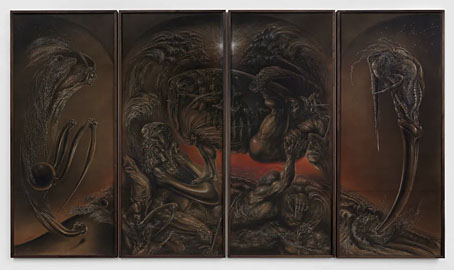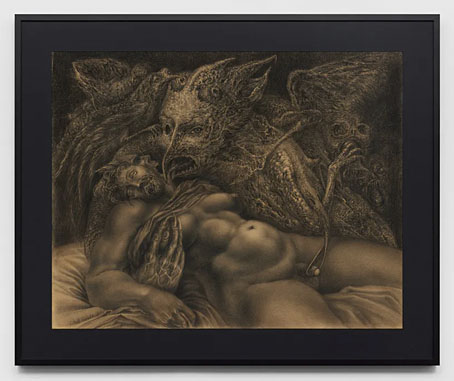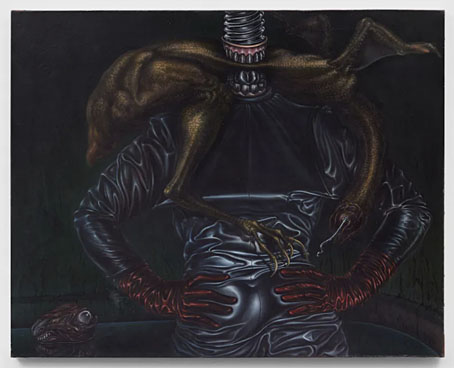La Bible du Mal (1978).
I’m late to this but it’s worth passing on the news about an exhibition of paintings, drawings and collages by Sibylle Ruppert (1942–2011) which is currently running at Project Native Informant in London. Ruppert’s art has been mentioned here many times, she’s one of my favourite artists, so it’s great to see her receiving more recognition, and in London as well, not Paris as I would have expected. I ought to go and see this but finishing the Bumper Book of Magic book took longer than I expected so I’ve had scheduled work backed up which I’m dealing with at the moment. I also don’t fancy taking another chance with Britain’s failing rail network, not when the last experience a few weeks ago was a bad one. But if you’re closer to London I’d recommend this exhibition which Artforum says is Ruppert’s first solo show in the UK.
Ma Soeur Mon Epouse (1975).
It’s tempting to connect the exhibition to this year’s 100th anniversary of Surrealism but I’ve never seen Ruppert’s name mentioned in Surrealist circles. She isn’t referred to in Penelope Rosemont’s wide-ranging Surrealist Women, for example, but then neither is Leonor Fini, possibly because Fini tried to maintain some distance from groups and movements. Was Ruppert the same? Without further information it’s hard to say. She was friends with HR Giger, however, and pictures by both artists may be seen in Providence (1977), the Alain Resnais film, as I noted a couple of years ago.
Frenzy of the Visible will be running until 20th April.
Le Sacrifice (1980).
Elsewhere on { feuilleton }
• The fantastic art archive
Previously on { feuilleton }
• Art on film: Providence
• Hans by Sibylle
• Sibylle Ruppert revisited
• Sibylle Ruppert, 1942–2011




Interesting artist! Looking online at some of her work, I’m reminded of Ernst Fuchs and Hans Bellmer. At least some of her work is the very definition of Surrealism, so I think placing her therein is appropriate.
Too bad you can’t make it to the exhibition. Perhaps they have produced a good catalogue for it; I wouldn’t mind getting one for myself. I’ll have to check in to it.
Bellmer was another artist featured in Providence, as it happens. I haven’t seen mention of a catalogue but I already have one for the exhibition held at the Giger Museum some years ago.
I may be able to get down there if I clear the decks a little more this week. I’m more concerned about having to deal with Euston Station again. All trains out of the place were cancelled earlier today, and I was stuck there on a hot day last summer.
I learned about SR right here on your site. Talk about underrated! She’s as good and even better than any of the Modern Masters. I love both Dali and Bellmer, but they could’ve learned a thing or two from SR. Her drawing is beyond exquisite. I’ve never understood how she could have been so unknown. Hopefully this exhibition brings her the recognition she deserved in life.
She had the misfortune to be most active at a time when this kind of art was very unpopular in the art world at large. Representational art was considered bad form for a while when Abstract Expressionism was at its height but it never really went away. After the 1940s, however, this kind of excessive imagination combined with a meticulous technique wasn’t encouraged at all. That didn’t stop the really determined artists like those in the Fantastic Realism group around Ernst Fuchs, but it did prevent them being more widely discussed and exhibited. Artists like Mati Klarwein and Giger became well known because of their work being used as illustrations in popular media (and Giger with Alien, of course). Also, Ruppert was a woman who wasn’t at all interested in dealing with typical women’s issues in her art like so many others in the 1970s.
I think she was well enough known in France; Alain Robbe-Grillet was an enthusiast and Resnais put her work on film, although all the pictures that appear in Providence are barely visible on small screens. The French also have a predilection for this kind of imaginative work to a degree you don’t find elsewhere. If Ruppert was still active today she’d probably have more of an audience. There are many more artists working today, and all of them desperately trying to find a distinctive niche in order to stand out from the crowd, that critics are no longer able to draw the kinds of boundaries they used to between the acceptable and the unacceptable.